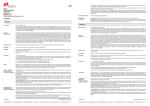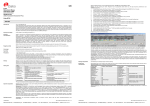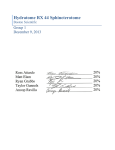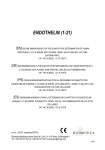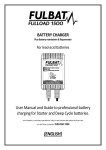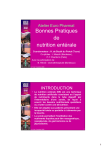Download FLEX Polyclonal Rabbit Anti-Human Gastrin Ready-to
Transcript
If the protocols are not available on the used Dako Autostainer instrument, please contact Dako Technical Services. Optimal conditions may vary depending on specimen and preparation methods, and should be determined by each individual laboratory. If the evaluating pathologist should desire a different staining intensity, a Dako Application Specialist/Technical Service Specialist can be contacted for information on re-programming of the protocol. Verify that the performance of the adjusted protocol is still valid by evaluating that the staining pattern is identical to the staining pattern described in “Performance characteristics”. FLEX Polyclonal Rabbit Anti-Human Gastrin Ready-to-Use (Dako Autostainer/Autostainer Plus) Counterstaining in hematoxylin is recommended using EnVision FLEX Hematoxylin, (Dako Autostainer/Autostainer Plus) (Code K8018). Non-aqueous, permanent mounting medium is recommended. Positive and negative controls should be run simultaneously using the same protocol as the patient specimens. The positive control tissue should include pyloric antrum of the stomach and the cells/structures should display reaction patterns as described for this tissue in “Performance characteristics” in all positive specimens. The recommended negative control reagent is FLEX Negative Control, Rabbit, (Dako Autostainer/Autostainer Plus) (Code IS600). Code IS519 ENGLISH Staining interpretation Cells labeled by the antibody display cytoplasmic staining. Performance characteristics Normal tissues: In stomach, G-cells in the pyloric antrum show moderate to strong staining reaction. The antibody does not label epithelial cells. Abnormal tissues: The antibody labeled 12/12 duodenal gastrinomas, 5/5 pancreatic gastrinomas, 8/8 gastrinomas in peripancreatic and periduodenal lymph nodes and liver without known primary tumor (1). In another study, the antibody labeled 3/11 pancreatic endocrine tumors (2). Intended use For in vitro diagnostic use. FLEX Polyclonal Rabbit Anti-Human Gastrin, Ready-to-Use (Dako Autostainer/Autostainer Plus), is intended for use in immunohistochemistry together with Dako Autostainer/Autostainer Plus instruments. This antibody labels gastrin and is useful for the identification of gastrin secreting neuroendocrine tumors (1, 2). The clinical interpretation of any staining or its absence should be complemented by morphological studies using proper controls and should be evaluated within the context of the patient's clinical history and other diagnostic tests by a qualified pathologist. FRANÇAIS Utilisation prévue Summary and explanation Pour utilisation lors d’un diagnostic in vitro. Gastrin is a peptide hormone that is important in the regulation of gastric acid secretion and mucosal cell proliferation (3). Progastrin is synthesized in G cells in the antropyloric mucosa, extraantral G cells and in endocrine cells of the pancreas and the pituitary gland. In G cells the progastin is concentrated into secretory granules, cleaved in the N- and C-terminal and amidated to form gastrin (4). The two major forms of gastin are gastrin-34 and gastrin-17 (3, 4). Secreted gastrin acts by binding to the G-coupled CKK2 receptor and stimulates the release of histamine from enterochromaffin-like cells. The released histamine acts as a paracrine stimulant on parietal cells that release gastric acid into the gut lumen (5). Gastrinomas are gastrin secreting neuroendocrine tumors (6) associated with the Zollinger-Ellison (ZES) syndrome or with the autosomal dominant inherited disorder multiple endocrine neoplasia type 1 (MEN1) syndrome. Sporadic gastrinomas are generally single and most commonly found in the pancreas but can be located to the duodenum. MEN1 associated gastrinomas are most often multiple and located to the duodenum (1, 7). FLEX Polyclonal Rabbit Anti-Human Gastrin, Ready-to-Use (Dako Autostainer/Autostainer Plus) est destiné à une utilisation en immunohistochimie avec les instruments Dako Autostainer/Autostainer Plus. L'anticorps marque la gastrine et permet l'identification des tumeurs neuroendocrines secrétant de la gastrine (1, 2). L’interprétation clinique de toute coloration ou son absence doit être complétée par des études morphologiques en utilisant des contrôles appropriés et doit être évaluée en fonction des antécédents cliniques du patient et d’autres tests diagnostiques par un pathologiste qualifié. Résumé et explication La gastrine est une hormone peptidique, importante dans la régulation de la sécrétion d'acide gastrique et la prolifération des cellules des muqueuses (3). La progastrine est synthétisée dans les cellules G de la muqueuse de l'antre pylorique, dans les cellules G extérieures à l'antre pylorique et dans les cellules endocrines du pancréas et de l'hypophyse. Dans les cellules G, la progastrine est concentrée en granules sécrétoires, clivée en terminaisons N et C et reçoit des acides aminés pour former la gastrine (4). Les deux formes principales de gastrine sont la gastrine-34 et la gastrine-17 (3, 4). La gastrine secrétée agit en se liant au récepteur CKK2 couplé à la cellule G et stimule la libération d'histamine par des cellules semblables aux cellules entérochromaffines. L'histamine libérée agit comme un stimulant à action paracrine sur les cellules pariétales qui libèrent l'acide gastrique dans la lumière du tractus intestinal (5). Refer to Dako’s General Instructions for Immunohistochemical Staining or the detection system instructions of IHC procedures for: 1) Principle of Procedure, 2) Materials Required, Not Supplied, 3) Storage, 4) Specimen Preparation, 5) Staining Procedure, 6) Quality Control, 7) Troubleshooting, 8) Interpretation of Staining, 9) General Limitations. Reagent provided Ready-to-use polyclonal rabbit antibody provided in liquid form in a buffer containing stabilizing protein and 0.015 mol/L sodium azide. Immunogen Synthetic human gastrin-17 non-sulphated form, coupled to bovine serum albumin. Les gastrinomes sont des tumeurs neuroendocrines secrétant de la gastrine (6), associés au syndrome de Zollinger-Ellison (SZE) ou aux néoplasies endocriniennes multiples de type 1 (NEM1), une maladie héréditaire à transmission autosomique dominante. Les gastrinomes sporadiques sont généralement simples et se trouvent le plus souvent dans le pancréas, bien qu'on puisse aussi en rencontrer dans le duodénum. Les NEM1 associées aux gastrinomes sont le plus souvent multiples et situées dans le duodénum (1, 7). Specificity The antibody reacts with human non-sulphated and sulphated forms of gastrin-17 as well as gastrin-34, and cross-reacts about 20% with cholecystokinin octapeptide (CCK-8). Traces of contaminating antibodies have been removed by solid-phase absorption with bovine plasma proteins. Se référer aux Instructions générales de coloration immunohistochimique de Dako ou aux instructions du système de détection relatives aux procédures IHC pour plus d’informations concernant les points suivants : 1) Principe de procédure, 2) Matériels requis mais non fournis, 3) Conservation, 4) Préparation des échantillons, 5) Procédure de coloration, 6) Contrôle de qualité, 7) Dépannage, 8) Interprétation de la coloration, 9) Limites générales. The specificity of the antibody has been ascertained as follows: Crossed immunoelectrophoresis: No precipitation arch appears when using 12.5 µL concentrated antibody per cm2 gel area against 2 µL of human plasma or 2 µL bovine serum. Staining: Coomassie Brilliant Blue. Precautions 1. For professional users. 2. This product contains sodium azide (NaN3), a chemical highly toxic in pure form. At product concentrations, though not classified as hazardous, sodium azide may react with lead and copper plumbing to form highly explosive build-ups of metal azides. Upon disposal, flush with large volumes of water to prevent metal azide build-up in plumbing. 3. As with any product derived from biological sources, proper handling procedures should be used. 4. Wear appropriate Personal Protective Equipment to avoid contact with eyes and skin. 5. Unused solution should be disposed of according to local, State and Federal regulations. Storage Store at 2-8 °C. Do not use after expiration date sta mped on vial. If reagents are stored under any conditions other than those specified, the conditions must be verified by the user. There are no obvious signs to indicate instability of this product. Therefore, positive and negative controls should be run simultaneously with patient specimens. If unexpected staining is observed which cannot be explained by variations in laboratory procedures and a problem with the antibody is suspected, contact Dako Technical Support. Specimen preparation including materials required but not supplied The antibody can be used for labeling formalin-fixed, paraffin-embedded tissue sections. Tissue specimens should be cut into sections of approximately 4 µm. Pre-treatment with heat-induced epitope retrieval (HIER) is required using Dako PT Link (Code PT100/PT101). For details, please refer to the PT Link User Guide. Optimal results are obtained by pretreating tissues using EnVision FLEX Target Retrieval Solution, High pH (50x) (Code K8010/K8004). Paraffin-embedded sections: Pre-treatment of formalin-fixed, paraffin-embedded tissue sections is recommended using the 3-in-1 specimen preparation procedure for Dako PT Link. Follow the pre-treatment procedure outlined in the package insert for EnVision FLEX Target Retrieval Solution, High pH (50x) (Code K8010/K8004). Note: After staining the sections must be dehydrated, cleared and mounted using permanent mounting medium. Deparaffinized sections: Pre-treatment of deparaffinized formalin-fixed, paraffin-embedded tissue sections is recommended using Dako PT Link and following the same procedure as described for paraffin-embedded sections. After staining the slides should be mounted using aqueous or permanent mounting medium. The tissue sections should not dry out during the treatment or during the following immunohistochemical staining procedure. For greater adherence of tissue sections to glass slides, the use of FLEX IHC Microscope Slides (Code K8020) is recommended. Staining procedure including materials required but not supplied Réactifs fournis Anticorps polyclonal de lapin prêt à l’emploi, fourni sous forme liquide dans un tampon contenant une protéine stabilisante et 0,015 mol/L d’azide de sodium Immunogène Forme non sulfatée de gastrine-17 humaine synthétique, associée à de l'albumine sérique d'origine bovine. Spécificité L'anticorps réagit avec les formes non sulfatée et sulfatée de gastrine -17 humaine ainsi qu'avec la gastrine-34 et présente une réaction croisée avec environ 20 % de cholécystokinine octapeptidique (CCK-8). Les traces d’anticorps contaminants ont été éliminées par absorption en phase solide en utilisant des protéines de plasma d'origine bovine. La spécificité de l’anticorps a été établie comme suit : Immunoélectrophorèse croisée : aucun arc de précipitation n'apparaît avec 12,5 µL d'anticorps concentré par cm2 de gel contre 2 µL de plasma humain ou 2 µL de sérum bovin. Coloration : bleu de Coomassie. Précautions 1. Pour utilisateurs professionnels. 2. Ce produit contient de l’azide de sodium (NaN3), produit chimique hautement toxique dans sa forme pure. Aux concentrations du produit, bien que non classé comme dangereux, l’azide de sodium peut réagir avec le cuivre et le plomb des canalisations et former des accumulations d’azides métalliques hautement explosifs. Lors de l’élimination, rincer abondamment à l’eau pour éviter toute accumulation d’azide métallique dans les canalisations. 3. Comme avec tout produit d’origine biologique, des procédures de manipulation appropriées doivent être respectées. 4. Porter un vêtement de protection approprié pour éviter le contact avec les yeux et la peau. 5. Les solutions non utilisées doivent être éliminées conformément aux réglementations locales et nationales. Conservation Conserver entre 2 et 8 °C. Ne pas utiliser après la date de péremption indiquée sur le flacon. Si les réactifs sont conservés dans des conditions autres que celles indiquées, celles-ci doivent être validées par l’utilisateur. Il n’y a aucun signe évident indiquant l’instabilité de ce produit. Par conséquent, des contrôles positifs et négatifs doivent être testés en même temps que les échantillons de patient. Si une coloration inattendue est observée, qui ne peut être expliquée par un changement des procédures du laboratoire, et en cas de suspicion d’un problème lié à l’anticorps, contacter l’assistance technique de Dako. Préparation des échantillons y compris le matériel requis mais non fourni L’anticorps peut être utilisé pour le marquage des coupes de tissus inclus en paraffine et fixés au formol. L’épaisseur des coupes d’échantillons de tissu doit être d’environ 4 µm. The recommended visualization system is EnVision FLEX, High pH, (Dako Autostainer/Autostainer Plus) (Code K8010). The staining steps and incubation times are pre-programmed into the software of Dako Autostainer/Autostainer Plus instruments, using the following protocols: Coupes incluses en paraffine : le prétraitement des coupes tissulaires fixées au formol et incluses en paraffine est recommandé à l'aide de la procédure de préparation d'échantillon 3-en-un pour le Dako PT Link. Suivre la procédure de prétraitement indiquée dans la notice de la EnVision FLEX Target Retrieval Solution, High pH (50x) (Réf. K8010/K8004). Remarque : après coloration, les coupes doivent être déshydratées, lavées et montées à l’aide d’un milieu de montage permanent. Template protocol: FLEXRTU2 (200 µL dispense volume) or FLEXRTU3 (300 µL dispense volume) Autoprogram: Gastrin (without counterstaining) or GastrinH (with counterstaining) The Auxiliary step should be set to “rinse buffer” in staining runs with ≤10 slides. For staining runs with >10 slides the Auxiliary step should be set to “none”. This ascertains comparable wash times. Coupes déparaffinées : le prétraitement des coupes tissulaires déparaffinées, fixées au formol et incluses en paraffine, est recommandé à l’aide du Dako PT Link, en suivant la même procédure que pour les coupes incluses en paraffine. Après coloration, un montage aqueux ou permanent des lames est recommandé. All incubation steps should be performed at room temperature. For details, please refer to the Operator’s Manual for the dedicated instrument. (117607-002) Dako Denmark A/S IS519/EFG/MNI/2009.12.04 p. 1/4 | Produktionsvej 42 | DK-2600 Glostrup | Denmark | Tel. +45 44 85 95 00 | Fax +45 44 85 95 95 | CVR No. 33 21 13 17 Un prétraitement avec démasquage d’épitope induit par la chaleur (HIER) est nécessaire avec le Dako PT Link (Réf. PT100/PT101). Pour plus de détails, se référer au Guide d’utilisation du PT Link. Des résultats optimaux sont obtenus en prétraitant les tissus à l’aide de la EnVision FLEX Target Retrieval Solution, High pH (50x) (Réf. K8010/K8004). (117607-002) Dako Denmark A/S IS519/EFG/MNI/2009.12.04 p. 2/4 | Produktionsvej 42 | DK-2600 Glostrup | Denmark | Tel. +45 44 85 95 00 | Fax +45 44 85 95 95 | CVR No. 33 21 13 17 Les coupes de tissus ne doivent pas sécher lors du traitement ni lors de la procédure de coloration immunohistochimique suivante. Pour une meilleure adhérence des coupes de tissus sur les lames de verre, il est recommandé d’utiliser des lames FLEX IHC Microscope Slides (Réf. K8020). Procédure de coloration y compris le matériel requis mais non fourni Vorbereitung der Probe und erforderliche, aber nicht mitgelieferte Materialien Le système de visualisation recommandé est le EnVision FLEX, High pH, (Dako Autostainer/Autostainer Plus) (Réf. K8010). Les étapes de coloration et les temps d’incubation sont préprogrammés dans le logiciel des instruments Dako Autostainer/Autostainer Plus, à l’aide des protocoles suivants : L’étape Auxiliary doit être réglée sur « rinse buffer » lors des cycles de coloration avec ≤10 lames. Pour les cycles de coloration de >10 lames, l’étape Auxiliary doit être réglée sur « none ». Cela confirme des temps de lavage comparables. Entparaffinierte Schnitte: Eine Vorbehandlung der entparaffinierten, formalinfixierten, paraffineingebetteten Gewebeschnitte mit Dako PT Link nach demselben Verfahren, wie für die paraffineingebetteten Schnitte beschrieben, wird empfohlen. Die Objektträger nach dem Färben mit einem wässrigen oder permanenten Einbettmedium bedecken. Toutes les étapes d’incubation doivent être effectuées à température ambiante. Pour plus de détails, se référer au Manuel de l’opérateur spécifique à l'instrument. Si les protocoles ne sont pas disponibles sur l’instrument Dako Autostainer utilisé, contacter le service technique de Dako. Il est recommandé d’effectuer une contre-coloration à l’aide de EnVision FLEX Hematoxylin, (Dako Autostainer/Autostainer Plus) (Réf. K8018). L’utilisation d’un milieu de montage permanent non aqueux est recommandée. Die Vorbehandlung durch hitzeinduzierte Epitopdemaskierung (HIER) mit Dako PT Link (Code-Nr. PT100/PT101) ist erforderlich. Weitere Informationen hierzu siehe PT Link-Benutzerhandbuch. Optimale Ergebnisse können durch Vorbehandlung der Gewebe mit EnVision FLEX Target Retrieval Solution, High pH (50x) (Code-Nr. K8010/K8004) erzielt werden. Paraffineingebettete Schnitte: Die Vorbehandlung der formalinfixierten, paraffineingebetteten Schnitte mit dem 3-in-1Probenvorbereitungsverfahren für Dako PT Link wird empfohlen. Vorbehandlung gemäß der Beschreibung in der Packungsbeilage für EnVision FLEX Target Retrieval Solution, High pH (50x) (Code-Nr. K8010/K8004) durchführen. Hinweis: Nach dem Färben müssen die Schnitte dehydriert, geklärt und mit permanentem Einbettmedium auf den Objektträger aufgebracht werden. Protocole modèle : FLEXRTU2 (volume d’application de 200 µL) ou FLEXRTU3 (volume d’application de 300 µL). Programme automatique : Gastrin (sans contre-coloration) ou GastrinH (avec contre-coloration). Les conditions optimales peuvent varier en fonction du prélèvement et des méthodes de préparation, et doivent être déterminées par chaque laboratoire individuellement. Si le pathologiste qui réalise l’évaluation désire une intensité de coloration différente, un spécialiste d’application/spécialiste du service technique de Dako peut être contacté pour obtenir des informations sur la reprogrammation du protocole. Vérifier que l'exécution du protocole modifié est toujours valide en vérifiant que le schéma de coloration est identique au schéma de coloration décrit dans les « Caractéristiques de performance ». Der Antikörper eignet sich zur Markierung von formalinfixierten und paraffineingebetteten Gewebeschnitten. Gewebeproben sollten in Schnitte von ca. 4 µm Stärke geschnitten werden. Die Gewebeschnitte dürfen während der Behandlung oder des anschließenden immunhistochemischen Färbeverfahrens nicht austrocknen. Zur besseren Haftung der Gewebeschnitte an den Glasobjektträgern wird die Verwendung von FLEX IHC Microscope Slides (Code-Nr. K8020) empfohlen. Färbeverfahren und erforderliche, aber nicht mitgelieferte Materialien Des contrôles positifs et négatifs doivent être réalisés en même temps et avec le même protocole que les échantillons du patient. Le contrôle de tissu positif doit comprendre l’antre pylorique de l'estomac et les cellules/structures doivent présenter les schémas de réaction décrits pour ces tissus dans les « Caractéristiques de performance » pour tous les échantillons positifs. Le réactif de contrôle négatif recommandé est le FLEX Negative Control, Rabbit, (Dako Autostainer/Autostainer Plus) (Réf. IS600). Das empfohlene Visualisierungssystem ist EnVision™ FLEX, High pH, (Dako Autostainer/Autostainer Plus) (Code-Nr. K8010). Die Färbeschritte und Inkubationszeiten sind in der Autostainer Link-Software vorprogrammiert. Die Färbeschritte und Inkubationszeiten sind in der Software der Dako Autostainer/Autostainer Plus-Geräte mit den folgenden Protokollen vorprogrammiert: Matrix-Protokoll: FLEXRTU2 (200 µL Abgabevolumen) oder FLEXRTU3 (300 µL Abgabevolumen) Autoprogram: Gastrin (ohne Gegenfärbung) oder GastrinH (mit Gegenfärbung) Bei Färbedurchläufen mit höchstens 10 Objektträgern sollte der „Zusatz“-Schritt auf „Pufferspülgang“ eingestellt werden. Für Färbedurchläufe mit mehr als 10 Objektträgern den „Zusatz“-Schritt auf „Keine“ einstellen. Dieses gewährleistet vergleichbare Waschzeiten. Interprétation de la coloration Les cellules marquées par l’anticorps présentent une coloration cytoplasmique. Alle Inkubationsschritte sollten bei Raumtemperatur durchgeführt werden. Nähere Einzelheiten bitte dem Benutzerhandbuch für das jeweilige Gerät entnehmen. Wenn die Färbeprotokolle auf dem verwendeten Dako Autostainer-Gerät nicht verfügbar sind, bitte den Technischen Kundendienst von Dako verständigen. Caractéristiques de performance Tissus sains : dans l'estomac, les cellules G de l'antre pylorique présentent une coloration modérée à forte. L'anticorps ne marque pas les cellules épithéliales. Optimale Bedingungen können je nach Probe und Präparationsverfahren unterschiedlich sein und sollten vom jeweiligen Labor selbst ermittelt werden. Falls der beurteilende Pathologe eine andere Färbungsintensität wünscht, kann ein Anwendungsspezialist oder Kundendiensttechniker von Dako bei der Neuprogrammierung des Protokolls helfen. Die Leistung des angepassten Protokolls muss verifiziert werden, indem gewährleistet wird, dass das Färbemuster mit dem unter „Leistungsmerkmale“ beschriebenen Färbemuster identisch ist. Tissus tumoraux : l'anticorps a marqué 12 cas sur 12 de gastrinome duodénal, 5 cas sur 5 de gastrinome pancréatique, 8 cas sur 8 de gastrinomes des ganglions lymphatiques péripancréatiques et périduodénaux et du foie sans tumeur primaire connue (1). Dans une autre étude, l'anticorps a marqué 3 cas sur 11 de tumeurs endocrines pancréatiques (2). Die Gegenfärbung in Hämatoxylin sollte mit EnVision FLEX Hematoxylin, (Dako Autostainer/Autostainer Plus) (Code-Nr. K8018) ausgeführt werden. Empfohlen wird ein nichtwässriges, permanentes Fixiermittel. Positiv- und Negativkontrollen sollten zur gleichen Zeit und mit demselben Protokoll wie die Patientenproben getestet werden. Das positive Kontrollgewebe sollte Gewebe vom Antrum pyloricum des Magens enthalten, und die Zellen/Strukturen müssen in allen positiven Proben die unter „Leistungsmerkmale“ für dieses Gewebe beschriebenen Färbemuster aufweisen. Das empfohlene negative Kontrollreagenz ist FLEX Negative Control, Rabbit, (Dako Autostainer/Autostainer Plus) (Code-Nr. IS600). DEUTSCH Verwendungszweck Zur In-vitro-Diagnostik. FLEX Polyclonal Rabbit Anti-Human Gastrin, Ready-to-Use (Dako Autostainer/Autostainer Plus) ist zur Verwendung in der Immunhistochemie in Verbindung mit Dako Autostainer/Autostainer Plus-Geräten bestimmt. Dieser Antikörper markiert Gastrin und dient zur Erkennung von Gastrin-sekretierenden, neuroendokrinen Tumoren (1, 2). Die klinische Auswertung einer eventuell eintretenden Färbung sollte durch morphologische Studien mit geeigneten Kontrollen ergänzt werden und von einem qualifizierten Pathologen unter Berücksichtigung der Krankengeschichte und anderer diagnostischer Tests des Patienten vorgenommen werden. Zusammenfassung und Erklärung Gastrin ist ein Peptidhormon, das bei der Regulierung der Magensäuresekretion und Schleimhautzellenproliferation eine wichtige Rolle spielt (3). Progastrin wird in G-Zellen in der Schleimhaut von Antrum und Pylorum, in G-Zellen außerhalb des Antrums und in endokrinen Zellen des Pankreas und der Hypophyse synthetisiert. In G-Zellen wird Progastrin durch Konzentration in Sekretgranula, Spaltung in N- und C-Terminale und Amidierung zu Gastrin umgewandelt (4). Die beiden Hauptformen von Gastrin sind Gastrin-34 und Gastrin-17 (3, 4). Sekretiertes Gastrin bindet sich an die G-gekoppelten CKK2-Rezeptoren und stimuliert die Freisetzung von Histamin in enterochromaffin-ähnlichen Zellen. Das freigesetzte Histamin wirkt als Parakrinstimulans auf Parietalzellen, die Magensäure in den Darmraum abgeben (5). Gastrinome sind Gastrin-sekretierende neuroendokrine Tumore (6), die mit dem Zollinger-Ellison (ZES) Syndrom oder mit der autosomaldominant vererbten Erkrankung Multiple endokrine Neoplasie Typ 1 (MEN1) assoziiert werden. Sporadische Gastrinome treten normalerweise einzeln und häufig im Pankreas auf, können sich aber auch im Duodenum bilden. MEN1-assoziierte Gastrinome treten meistens mehrfach auf und bilden sich im Duodenum (1, 7). Folgende Angaben bitte den Allgemeinen Richtlinien zur immunhistochemischen Färbung von Dako oder den Anweisungen des Detektionssystems für IHC-Verfahren entnehmen: 1) Verfahrensprinzip, 2) Erforderliche, aber nicht mitgelieferte Materialien, 3) Aufbewahrung, 4) Vorbereitung der Probe, 5) Färbeverfahren, 6) Qualitätskontrolle, 7) Fehlersuche und -behebung, 8) Auswertung der Färbung, 9) Allgemeine Beschränkungen. Geliefertes Reagenz Gebrauchsfertiger polyklonaler Kaninchen-Antikörper in flüssiger Form in einem Puffer, der stabilisierendes Protein und 0,015 mol/L Natriumazid enthält. Immunogen Synthetisches menschliches Gastrin-17 in nicht-sulfatierter Form, gekoppelt mit Rinderserumalbumin (BSA). Spezifität Der Antikörper reagiert mit menschlichen, nicht-sulfatierten und sulfatierten Formen von Gastrin-17 und Gastrin-34 und kreuzreagiert zu ungefähr 20 % mit Cholecystokinin-Oktapeptid (CCK-8). Spuren von Verunreinigungen durch Antikörper wurden durch Festphasen-Absorption mit Rinderplasmaproteinen entfernt. Auswertung der Färbung Mit diesem Antikörper markierte Zellen weisen ein zytoplasmatisches Färbemuster auf. Leistungsmerkmale Gesundes Gewebe: Im Magen zeigen G-Zellen des Antrum pyloricum eine mäßige bis starke Färbereaktion. Der Antikörper markiert Epithelzellen nicht. Pathologisches Gewebe: Der Antikörper markierte 12 von 12 Zwölffingerdarm-Gastrinomen, 5 von 5 Pankreas-Gastrinomen, 8 von 8 Gastrinomen in peripankreatischen und periduodenalen Lymphknoten und der Leber ohne bekannte Primärtumore (1). In einer anderen Studie markierte der Antikörper 3 von 11 pankreatischen Endokrintumoren (2). References/ Références/ Literatur 1. Perkins PL, McLeod MK, Jin L, Fukuuchi A, Cho KJ, Thompson NW, et al. Analysis of gastrinomas by immunohistochemistry and in situ hybridization histochemistry. Diag Mol Path 1992;1:155-4. 2. Wang G, Yao J, Worah S, White J, Luna R, Wu TT et al. Comparison of genetic alterations in neuroendocrine tumors: frequent loss og chromosome 18 in ileal carcinoid tumors. Modern Path 2005;18: 1079-87. 3. Thomas RP, Hellmich MR, Townsend CM and Evers BM. Role of gastrointestinal hormones in the proliferation of normal and neoplastic tissues. Endocrine Rev 2003;24:571-99. 4. Dickinson CJ. Relationship of gastrin processing to colon cancer. Gastroenterology 1995;109:1384-8 5. Dimaline R, Varro A. Attack and defence in the gastric epithelium-a delicate balance. Exp Physiol 2007;92:591-601. 6. de Herder W. Biochemistry of neuroendocrine tumors. Best Pract Res Clin Endocrinol Metab 2007;21:33-41. 7. Pritchard DM. Pathogenesis of gastrinomas associated with multiple endocrine neoplasia type 1. Gut 2007:56 606-7. Explanation of symbols/ Explication des symboles/ Erläuterung der Symbole Die Spezifität dieses Antikörpers wurde wie folgt ermittelt: Gekreuzte Immunelektrophorese: Bei Verwendung von 12,5 µL konzentriertem Antikörper pro cm Gelfläche mit 2 µL Humanplasma oder 2 µL Rinderserum erscheint keine halbmondförmige Präzipitatlinie. Färbung: Coomassie Brilliant Blue. 2 Vorsichtsmaßnahmen Lagerung (117607-002) Dako Denmark A/S 1. Nur für Fachpersonal bestimmt. 2. Dieses Produkt enthält Natriumazid (NaN3), eine in reiner Form äußerst giftige Chemikalie. Natriumazid kann auch in als ungefährlich eingestuften Konzentrationen mit Blei- und Kupferrohren reagieren und hochexplosive Metallazide bilden. Nach der Entsorgung stets mit viel Wasser nachspülen, um Metallazidansammlungen in den Leitungen vorzubeugen. 3. Wie alle Produkte biologischen Ursprungs müssen auch diese entsprechend gehandhabt werden. 4. Geeignete Schutzkleidung tragen, um Augen- und Hautkontakt zu vermeiden. 5. Nicht verwendete Lösung ist entsprechend örtlichen, bundesstaatlichen und staatlichen Richtlinien zu entsorgen. Catalogue number Référence catalogue Bestellnummer Temperature limitation Limites de température Use by Utiliser avant Zulässiger Temperaturbereich Verwendbar bis In vitro diagnostic medical device Dispositif médical de diagnostic in vitro In-vitro-Diagnostikum Contains sufficient for <n> tests Contenu suffisant pour <n> tests Manufacturer Fabricant Inhalt ausreichend für <n> Tests Hersteller Consult instructions for use Voir les instructions d’utilisation Gebrauchsanweisung beachten Batch code Numéro de lot Chargenbezeichnung Bei 2–8 °C aufbewahren. Nach Ablauf des auf dem Fläsch chen aufgedruckten Verfalldatums nicht mehr verwenden. Werden die Reagenzien unter anderen als den angegebenen Bedingungen aufbewahrt, müssen diese Bedingungen vom Benutzer validiert werden. Es gibt keine offensichtlichen Anzeichen für eine eventuelle Produktinstabilität. Positiv- und Negativkontrollen sollten daher zur gleichen Zeit wie die Patientenproben getestet werden. Falls es zu einer unerwarteten Färbung kommt, die sich nicht durch Unterschiede bei Laborverfahren erklären lässt und auf ein Problem mit dem Antikörper hindeutet, ist der technische Kundendienst von Dako zu verständigen. IS519/EFG/MNI/2009.12.04 p. 3/4 | Produktionsvej 42 | DK-2600 Glostrup | Denmark | Tel. +45 44 85 95 00 | Fax +45 44 85 95 95 | CVR No. 33 21 13 17 (117607-002) Dako Denmark A/S IS519/EFG/MNI/2009.12.04 p. 4/4 | Produktionsvej 42 | DK-2600 Glostrup | Denmark | Tel. +45 44 85 95 00 | Fax +45 44 85 95 95 | CVR No. 33 21 13 17





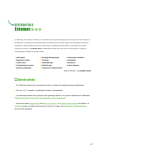
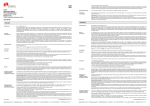
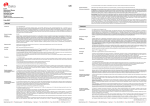

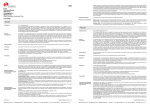

![Acctiva Professional 35 A [42,0426,0093,DE]](http://vs1.manualzilla.com/store/data/006740664_1-5560c8c3a0a8a7fe535db48be81090f9-150x150.png)
